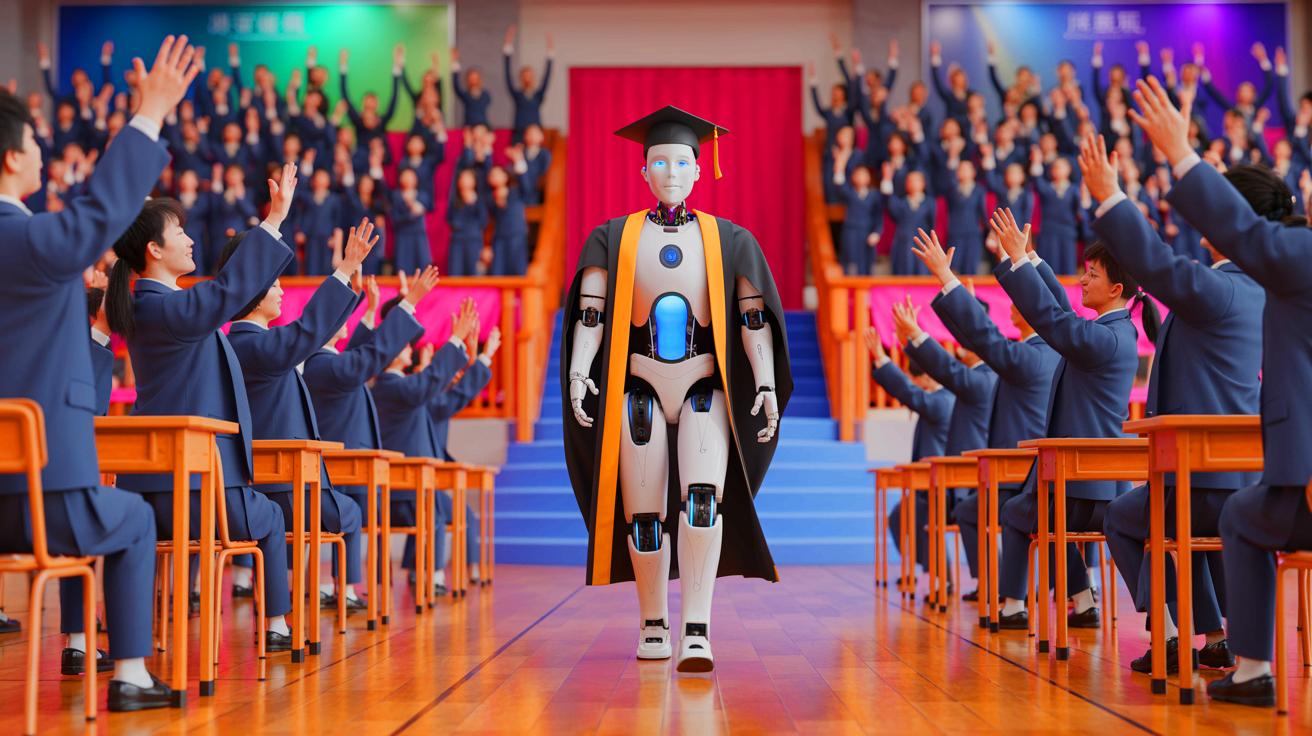| IN A NUTSHELL |
|
In a world rapidly embracing technological innovation, the sight of a humanoid robot participating in a high school graduation ceremony in China is emblematic of the startling pace at which robotics is integrating into everyday life. This event, featuring the humanoid robot Shuang Shuang, also known as ‘Bright’, took place during the 25th commencement ceremony at Shuangshi High School in Fujian, China. As the robot shook hands with a professor and received a ‘certificate’, it became a symbol of China’s burgeoning prowess in the field of humanoid robotics. But what does this mean for the future of human-robot interactions, and how is this development perceived on the global stage?
The Rise of Humanoid Robots in China
China is swiftly becoming a leader in the field of humanoid robotics, as demonstrated by Shuang Shuang’s appearance at a high-profile cultural event. This phenomenon underscores the country’s commitment to advancing its technological capabilities and integrating them into societal milestones. Shuang Shuang’s participation in the graduation ceremony was not just a display of advanced technology but also a testament to the growing acceptance of robots in public life. The event was met with enthusiasm and applause, highlighting China’s readiness to embrace these technological advancements.
The demand for humanoid robots in China is on the rise, driven by both governmental initiatives and private sector investments. This surge is part of a broader trend that sees robots, both humanoid and otherwise, becoming more prevalent in various sectors, including education, healthcare, and security. As the country continues to invest heavily in robotics, it sets the stage for further integration of these machines into daily life, potentially reshaping societal norms and expectations.
“Robot Jumps 41% Higher”: MIT’s New AI Outsmarts Human Engineers With Record-Breaking Design That Defies Gravity
Global Competition: The Race for Robotic Supremacy
The United States remains one of China’s most formidable competitors in the realm of robotics. Companies like Tesla, led by Elon Musk, are at the forefront of this competition. Tesla’s development of the Optimus humanoid robot, designed to perform household chores and potentially replace human workers, exemplifies the intense focus on robotics in the U.S. However, technical challenges have delayed Optimus’s release, illustrating the complexities involved in bringing such advanced technologies to market.
In addition to humanoid robots, the U.S. is also exploring the use of security robots in real-world scenarios. Robot dogs, for example, are being deployed to assist with security at high-profile locations like Mar-a-Lago. These developments highlight the diverse applications of robotics and the ongoing efforts by various nations to harness the potential of these technologies not just for economic gain, but also for societal benefits.
“These Robot Eyes See What We Can’t!”: Breakthrough Technology Lets Machines Outspeed Human Vision by Reacting to Blinding Light Five Times Faster
The Symbolism Behind Shuang Shuang’s Graduation
While Shuang Shuang’s participation in the graduation ceremony was visually striking, questions remain regarding the significance of the event. The robot’s receipt of a ‘certificate’ during the ceremony was symbolic rather than indicative of any academic achievement. This raises intriguing questions about the role of robots in educational settings and whether they can truly be integrated into such traditional institutions.
The lack of information about Shuang Shuang’s intellectual capabilities further complicates the narrative. Despite this, the robot’s presence at the ceremony represents a broader trend of automation and robotics intertwining with cultural and social events. The symbolism of the event may outweigh its practical implications, but it nevertheless marks an important step in the evolving relationship between humans and machines.
This Bizarre Electronic Ink Morphs in Real Time and Could Power a Whole New Class of Bendable, Wearable Devices
Looking to the Future: The Impact of Robotics on Society
As we continue to witness events like Shuang Shuang’s graduation, it becomes clear that robotics will play an increasingly prominent role in shaping the future. These machines are not just tools but potential partners in our daily lives, capable of performing tasks, assisting in education, and even participating in cultural ceremonies. The rapid advancements in robotics signal a future where humans and robots coexist more closely than ever before.
As China and other nations push the boundaries of what robots can achieve, we are left to consider the implications of these developments. How will society adapt to the presence of robots in traditional settings? What ethical considerations must be addressed as we invite robots into more intimate aspects of our lives? These questions will guide the discourse on the role of robotics in the coming years, inviting us to ponder the possibilities and challenges of a tech-driven future.
This article is based on verified sources and supported by editorial technologies.
Did you like it? 4.5/5 (23)
